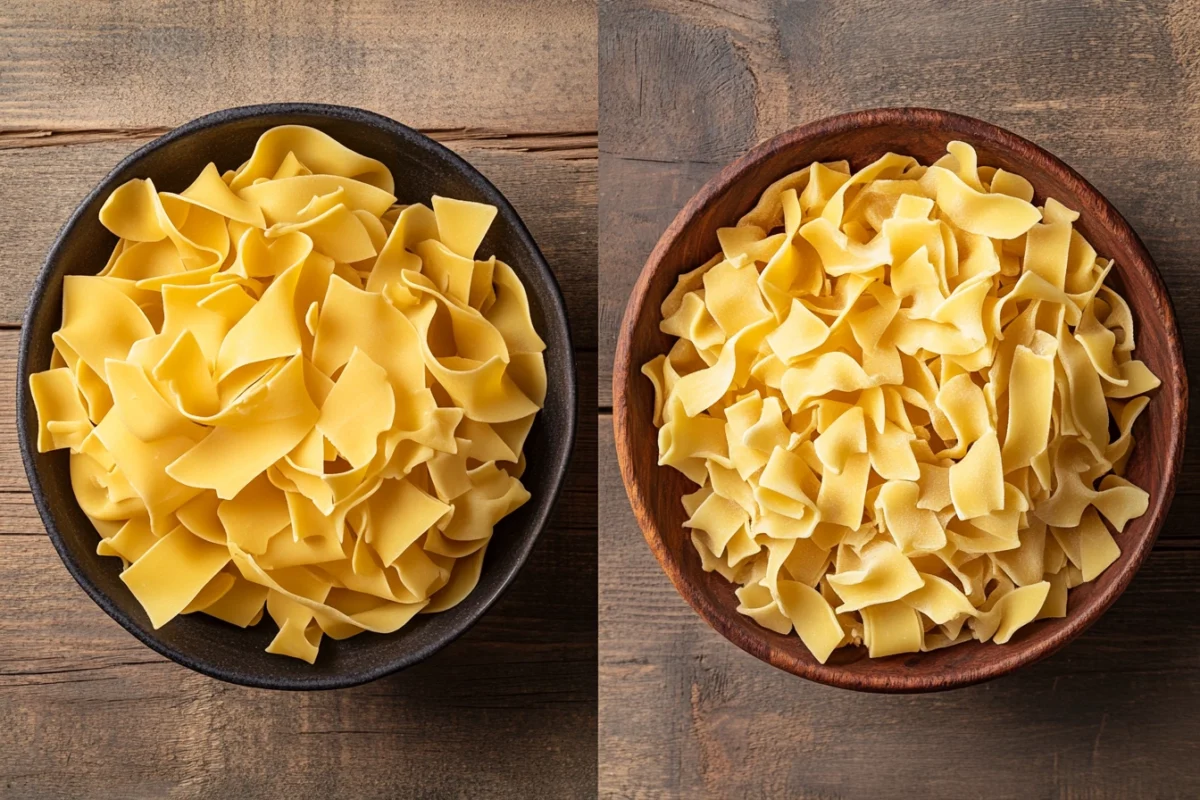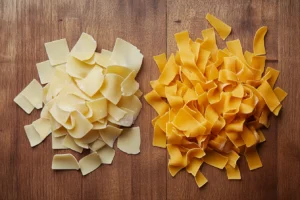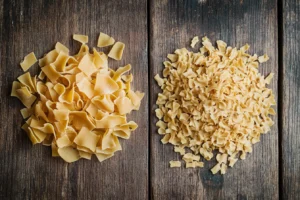Comparing pappardelle and egg noodles might seem tricky. However, their differences in width, shape, and usage are key. This article helps clarify their unique qualities.
Exploring the Basics: What’s the Difference Between Pappardelle and Egg Noodles
Understanding the world of pasta can be quite confusing, especially when similar-looking types exist. Therefore, let’s delve into the nuances of two popular options: pappardelle and egg noodles. What’s the difference between pappardelle and egg noodles is a common query. We will explore this question thoroughly. Accordingly, this article will address their distinctions in shape, texture, and culinary uses. This will provide a clearer understanding. Moreover, we will look at the origins and history of each type, giving a richer context. Furthermore, we will discuss how to choose the best option for your needs. Finally, we will offer some practical tips for cooking each of them perfectly.
Shape and Size: A Visual Comparison
The first, and perhaps most noticeable, difference between pappardelle and egg noodles lies in their shape. Pappardelle are wide, flat ribbons of pasta. They are typically about ¾ to 1 inch wide. Conversely, egg noodles come in various widths. However, they are generally narrower. In addition, they are usually shorter than pappardelle. This difference in size affects how each pasta interacts with sauces. Therefore, this is a key consideration in cooking. Specifically, the width affects how well the pasta holds the sauce. Another consideration is how each pasta cooks. The shape of the pasta influences its cooking time.
Pappardelle: The Wide Ribbon
Pappardelle’s defining characteristic is their substantial width. Furthermore, they are often cut with a ruffled edge for added texture. This wide surface area allows them to hold rich, hearty sauces exceptionally well. For example, thick meat ragùs or creamy sauces work perfectly with pappardelle. Indeed, their wide surface is designed for heavier sauces. Moreover, this shape allows you to taste both the pasta and the sauce. The ruffles also increase the surface area. This adds to the sauce-holding capacity.
Egg Noodles: The Flexible Option
Egg noodles, on the other hand, are much more versatile. While there are wider egg noodle options, they usually appear as thin, flat noodles. The width can vary, which makes them suitable for diverse dishes. Egg noodles are great in soups, stir-fries, or with lighter sauces. They adapt well to different cooking styles. Additionally, egg noodles can be found in different shapes. They can be twisted or curly. Their versatility makes them a common choice for home cooks. Also, they come in various sizes. This makes them ideal for many kinds of dishes.
Texture and Composition: Key Variations
Besides their shape, the texture and composition of these two types of pasta provide further differences. Pappardelle, usually made with egg and flour, has a firm, slightly chewy texture when cooked. Conversely, egg noodles, which often contain a higher ratio of egg, are typically softer and more tender. Therefore, understanding this difference is key. This knowledge can help you match the right pasta with the right sauce.
Pappardelle’s Firm Bite
Pappardelle’s slightly firmer texture allows it to stand up well to heavier sauces. This characteristic makes it a wonderful pairing for robust meals. Additionally, pappardelle’s thickness gives it a satisfying mouthfeel. Therefore, it’s often preferred for more sophisticated dishes. Furthermore, the firm texture prevents the pasta from becoming mushy. This keeps the pasta at the center of the dish. Also, the slight chewiness enhances the enjoyment of the meal.
Egg Noodles’ Tender Embrace
Egg noodles, by comparison, offer a more delicate and tender texture. This texture allows them to absorb flavors effectively. Moreover, egg noodles’ softness makes them ideal for dishes where a lighter feel is desired. Therefore, they are fantastic in broths or with subtle sauces. Specifically, their delicate texture makes them melt in your mouth. Furthermore, the tender texture allows the flavors to be easily absorbed. Moreover, the soft texture is a great choice for light and simple meals.
Usage in Cooking: How They Shine
What’s the difference between pappardelle and egg noodles also becomes apparent in their culinary applications. Pappardelle is often chosen for Italian dishes where a thick, substantial sauce is the star. Egg noodles, however, find their place in a much wider range of global cuisines. Hence, the choice depends greatly on what kind of meal you want. Each type has its own place and function.
Pappardelle in Italian Cuisine
Pappardelle shines in Italian cooking. Especially when it comes to dishes featuring rich, slow-cooked sauces. For example, a classic Bolognese sauce with pappardelle is a memorable pairing. Moreover, pappardelle can also be paired with creamy mushroom sauces or hearty wild boar ragù. Additionally, consider using pappardelle with braised meats. Also, you may pair them with a robust seafood ragu. Therefore, pappardelle is ideal for a big, bold meal.
Egg Noodles Around the World
Egg noodles are amazingly versatile. Specifically, you will find them in soups, casseroles, and Asian stir-fries. Their flexibility makes them a staple in many households. In addition, they are commonly used in comforting classics like chicken noodle soup or stroganoff. Therefore, they adapt well to diverse flavor profiles. Indeed, they are a great choice for soups and broths from around the world. Moreover, they are perfect for quick meals when you want a simple dish. Furthermore, their versatility makes them useful in many different cuisines.
What’s the Difference Between Pappardelle and Egg Noodles: Understanding the Flour
The type of flour used in making pasta influences its final texture. Pappardelle generally uses a higher proportion of semolina flour. This leads to a sturdier, slightly firm pasta. Conversely, egg noodles are often made with a blend of all-purpose flour. This contributes to their softer, more tender texture. Therefore, the choice of flour is a key factor in the final product. Specifically, the type of flour influences both the texture and taste of the pasta.
Semolina’s Contribution to Pappardelle
Semolina flour is known for its characteristic coarse texture. This texture leads to a firmer and slightly chewier pasta. Accordingly, this makes pappardelle an excellent choice for robust dishes. Furthermore, the semolina gives it a golden hue and a distinct flavor. Additionally, semolina flour adds a nutty flavor. Also, this flavor can enhance the overall dining experience. Indeed, this flour is a good choice for a hearty pasta dish.
All-Purpose Flour in Egg Noodles
The all-purpose flour used in egg noodles results in a smoother, more delicate texture. Therefore, this makes egg noodles perfect for dishes requiring a gentler bite. Moreover, the softness allows the noodles to readily absorb flavors from broths and sauces. Furthermore, all-purpose flour creates a softer pasta dough. Also, this dough is easier to work with. Hence, all-purpose flour makes the pasta more versatile for various sauces.
Egg Content: Another Point of Divergence
The egg content also influences the texture and color of the pasta. Typically, egg noodles have a higher ratio of egg than pappardelle. This results in a richer flavor and a more yellow color. However, both types include egg. The amount used makes a big difference. Thus, this variation in the amount of egg contributes significantly to each type of pasta’s characteristics. Specifically, this affects texture and taste.
High Egg Content in Egg Noodles
The higher egg content in egg noodles contributes to their softer texture. Also, this gives them a richer flavor. Specifically, this higher amount gives the noodles a more tender consistency after cooking. Additionally, they often have a more vibrant yellow hue. Moreover, the egg content enhances the nutritional value. Furthermore, the egg adds an extra richness to the taste.
Lower Egg Ratio in Pappardelle
Pappardelle, on the other hand, may use less egg. This helps in creating the characteristic firmer texture. Specifically, the pasta aims for a slightly chewier bite, not too tender. Therefore, this distinction contributes to the overall sensory experience. Additionally, less egg helps the pasta stay firm. Also, this reduces the risk of mushiness. Hence, it is designed for heavier sauces.
Sauce Pairing: Making the Right Choice
Knowing what’s the difference between pappardelle and egg noodles helps in pairing them with the correct sauces. Pappardelle, with its wide surface, works best with thicker, hearty sauces. Egg noodles, with their versatile nature, pair well with lighter sauces, broths, and creamy mixtures. Therefore, choosing the right pasta for your sauce is important. Specifically, the right combination enhances the flavor of your meal.
Pappardelle and Hearty Sauces
Pappardelle is the ideal choice when your dish features a thick, chunky sauce. For example, meat ragùs, wild mushroom sauces, or slow-cooked stews are great choices. Accordingly, their wide shape and firm texture allow them to hold onto the sauce perfectly. Furthermore, the wide surface area ensures the sauce coats the noodles well. Also, the robust texture of the pappardelle stands up well to the hearty sauces. Indeed, this combination makes for a satisfying meal.
Egg Noodles and Light Sauces
Egg noodles are excellent for lighter, more delicate sauces. Therefore, creamy sauces, simple butter sauces, or clear broths are great options. In addition, their tender texture allows them to easily absorb the flavors of the sauce. Moreover, their soft texture enhances the eating experience. Also, they are an ideal choice for a quick light meal. Furthermore, they pair very well with vegetable-based sauces.
Cooking Time and Techniques: Getting It Right
What’s the difference between pappardelle and egg noodles also includes their cooking times. Pappardelle, due to its thickness, typically requires a longer cooking time. Conversely, egg noodles, especially the thinner varieties, cook more quickly. Thus, it is crucial to be aware of this difference. Specifically, proper cooking will ensure the best taste and texture of each pasta.
Pappardelle’s Longer Cooking Duration
Pappardelle usually needs about 8 to 10 minutes of cooking time. However, it can vary. It is essential to check for doneness. This ensures the pasta is firm but cooked through. The wider ribbons need a bit longer to get the best texture. Additionally, check the pasta often. This prevents it from becoming too soft. Also, the cooking time may depend on the pasta’s thickness and freshness.
Egg Noodles’ Quick Cooking Process
Egg noodles often cook in as little as 5 to 7 minutes. However, it also depends on their thickness. Checking them frequently is important. It ensures that they do not overcook and become too soft. The tender texture makes them cook fast. Indeed, overcooking egg noodles will make them mushy. Furthermore, the cooking time may change depending on the specific type of egg noodles.
Making Your Own: Home Preparation Tips
Making pasta from scratch can be a fun and satisfying experience. However, the process for pappardelle and egg noodles differs slightly. Understanding these nuances can help you achieve the best results. Hence, preparing fresh pasta at home can be very rewarding. Also, it allows you to customize your recipe based on your own preferences.
Pappardelle at Home
For pappardelle, a slightly firmer dough is preferred. The dough needs to be rolled thin. Then it’s cut into wide ribbons. Therefore, this process needs some precision. A pasta machine can help with making it uniform. Specifically, a slightly firm dough provides a good texture. Additionally, a pasta machine helps achieve the ideal thickness. Also, you can use a knife to cut the ribbons if you don’t have a machine.
Egg Noodles at Home
When making egg noodles at home, aim for a slightly softer dough. The dough should be rolled to the desired thickness. Then cut into the shapes you prefer. Indeed, this dough can be more forgiving. So, it is suitable for beginners. Specifically, the softer dough makes it easier to roll and cut. Furthermore, the thickness can be tailored to your preferences. Also, various shapes can be achieved.
Nutritional Aspects: Considering the Differences
Both pappardelle and egg noodles provide nutrients. However, their nutritional profiles can vary based on the ingredients. Egg noodles, often with a higher egg content, may have more protein. This depends on the recipe. Therefore, it is a good idea to check the exact nutritional value for specific recipes.
Nutritional Content of Pappardelle
Pappardelle’s nutritional value depends on the flour and egg content. It provides carbohydrates and a small amount of protein. Always check the exact recipe. The nutrients can vary with the ingredients used. Additionally, the nutritional value changes when you add the sauce and toppings. Also, you may want to consider the portions you are serving.
Nutritional Value of Egg Noodles
Egg noodles are often richer in protein. They provide a balanced blend of carbohydrates and protein. Additionally, the egg content contributes to the nutritional benefits. Again, check the recipe for the specific ingredient amounts. Moreover, the nutritional value will vary depending on the type of egg noodles. Also, whole wheat egg noodles might have more fiber.
What’s the Difference Between Pappardelle and Egg Noodles: A Summary
What’s the difference between pappardelle and egg noodles is a question answered through their shape, texture, and uses. Pappardelle, with its wide ribbons, is suited for heavy sauces. Egg noodles, with their versatility, work in a range of dishes. Therefore, understanding these differences helps choose the right pasta for your recipes. Indeed, knowing these differences will help you create better dishes. Specifically, it is about matching the right pasta with the right meal..
FAQs (People Also Ask)
Can I substitute egg noodles for pappardelle in a recipe?
Substituting egg noodles for pappardelle can work. However, it will affect the texture. Pappardelle’s wide surface holds heavy sauces better. Egg noodles may not offer the same experience. Therefore, the sauce could slide off. Additionally, the cooking times for each pasta are different. Also, the final meal might not have the same taste and appearance.
Are pappardelle and egg noodles both made with egg?
Yes, both pappardelle and egg noodles are typically made with egg. However, the proportion of egg can vary. Egg noodles often have a higher ratio of egg. This contributes to their tender texture and flavor. Specifically, the ratio of egg will affect the texture and taste of each type. Also, some vegan recipes may not use egg.
Which type of pasta is better for a creamy sauce?
Egg noodles can work well with creamy sauces. However, pappardelle is often preferred. This is because its wide surface can hold the sauce. Therefore, it is a matter of personal preference. Additionally, you may want to consider the thickness of the creamy sauce. Also, a light creamy sauce will pair well with both types.
Which is healthier: pappardelle or egg noodles?
The nutritional value of pappardelle and egg noodles is similar. The main difference is in the ingredients and proportions used. Egg noodles might have a higher protein content. This is due to a higher ratio of egg. Always consider the other ingredients in your meal for a balanced choice. Furthermore, the way you prepare the pasta will affect its nutritional value. Also, watch for high-fat sauces and toppings.
Conclusion: Selecting the Right Pasta
In summary, choosing between pappardelle and egg noodles depends on the recipe and desired outcome. Pappardelle is great for hearty Italian meals. On the other hand, egg noodles provide flexibility for a variety of global dishes. Now that you know what’s the difference between pappardelle and egg noodles, you can make more informed choices. So, enjoy experimenting in the kitchen! Thus, it is up to your personal preference and what you are trying to cook.
If you’re wondering why it pairs so well with hearty recipes, visit Why is pappardelle so good?.



